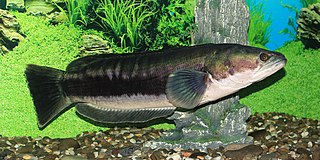
Channa is a genus of predatory fish in the family Channidae, commonly known as snakehead, native to freshwater habitats in Asia. This genus contains about 50 scientifically described species. The genus has a wide natural distribution extending from Iraq in the west, to Indonesia and China in the east, and parts of Siberia in the Far East. A particularly high richness of species exists in Myanmar (Burma) and northeastern India, and many Channa species live nowhere else. In contrast, a few widespread species have been introduced to several regions outside their natural range where they often become invasive. The large and medium-sized Channa species are among the most common staple food fish in several Asian countries and they are extensively cultured. Apart from their importance as a food fish, snakeheads are consumed in some regions as a traditional medicine for wound healing and reducing post-operative pain and discomfort, and collected for the international aquarium pet trade.

Dwarf snakehead is a term coined by aquarists to describe a group of Channa snakehead fishes growing to about 25 cm (10 in) maximum. They are found in freshwater habitats in South and Southeast Asia, and southern China.

Lamprologus is a genus of fishes from the cichlid family. They are native to Lake Tanganyika and the Congo River Basin in Africa. The type species for this genus is Lamprologus congoensis, a species from the Congo River. The genus is under some revision and may eventually be restricted to these riverine types.

Xenotilapia is a genus of cichlids species endemic to Lake Tanganyika in east Africa.
Tylognathus is an invalid genus of ray-finned fishes in the family Cyprinidae. It was established by Heckel in 1843 without a type species. Varicorhinus diplostomus, described by Heckel in 1838 and erroneously redescribed by the same author in 1844 as T. valenciennesii, was later designated the type species. Today this fish is placed in the genus Bangana.
Lamprologus ornatipinnis is a species of cichlid endemic to Lake Tanganyika where it prefers areas with sandy substrates or, sometimes rocky areas. While not a shell dweller like many of its congeners, it does use shells for spawning. This species can reach a length of 7.8 centimetres (3.1 in) TL. This species can also be found in the aquarium trade.
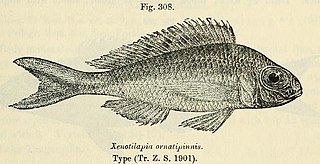
Xenotilapia ornatipinnis is a species of cichlid endemic to Lake Tanganyika where it can be found in schools in areas with sandy substrates. This species can reach a length of 12.5 centimetres (4.9 in) TL. It can also be found in the aquarium trade.

Polypterus ornatipinnis, the ornate bichir, is a bony fish found in Lake Tanganyika and the Congo River basin in Central and East Africa.
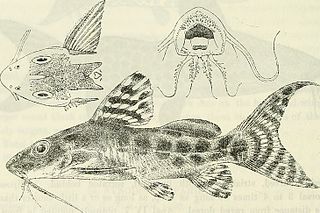
Synodontis ornatipinnis, known as the barfin synodontis, is a species of upside-down catfish that is native to the Congo Basin of the Democratic Republic of the Congo and Zambia. It was first described by British-Belgian zoologist George Albert Boulenger in 1899, from specimens collected in Mbandaka, on the Congo River in what is now the Democratic Republic of the Congo. The species name ornatipinnis means "ornate fins".

The Siamese mud carp is a species of freshwater cyprinid fish, a variety of Asian carp native to the Mekong and Chao Phraya Rivers in Southeast Asia, especially in Cambodia, Laos and Thailand. It is very common in floodplains during the wet season and migrates upstream in the Mekong starting in Cambodia.
Henicorhynchus caudimaculatus is a species of ray-finned fish in the genus Henicorhynchus.
Henicorhynchus inornatus is a species of ray-finned fish in the genus Henicorhynchus, although some authorities classify it as member of the genus Cirrhinus. It is only found in the Irrawaddy and Sittang basins in Myanmar.
Henicorhynchus is a genus of cyprinid fish that occurs in Southeast Asia with one species extending into China. There are currently 7 species in this genus.
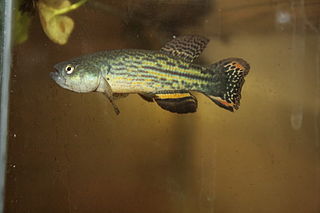
Neofundulus is a genus of fish in the family Rivulidae. These annual killifish are endemic to the Paraguay, Guaporé, Mamoré and São Francisco basins in Argentina, Bolivia, Brazil and Paraguay. They inhabit temporary waters, such as swamps or ponds, that typically are located in open habitats like grassland. Once the water disappears, the adults die, but the eggs that have been laid in the bottom remain, only hatching after several months when the water returns.
Repomucenus is a genus of dragonets native to the Indian Ocean and the western Pacific Ocean. This genus also includes one freshwater species (R. olidus).
Henicorhynchus lobatus is a species of freshwater fish in the family Cyprinidae. It is endemic to Indochina. It is common in the Mekong and also occurs in the Mae Klong and Chao Phraya basins as well as in the associated lowland areas. It is a keystone species in the Mekong.
Henicorhynchus horai is a species of cyprinid fish endemic to Inle Lake in Myanmar.
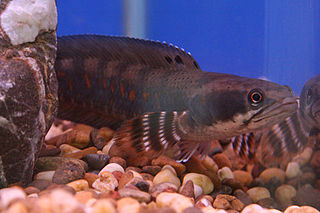
Channa pulchra is a species of snakehead fish in the family Channidae which is native to Myanmar. It was first described in 2007 by R. Britz from a specimen collected from the Kyeintali Chaung (stream) basin in Rakhine Yoma, western Myanmar. The fish is found in streams that are fast flowing, clear, highly oxygenated and relatively cold (subtropical). It is of little food value but getting popularity as an aquarium fish recently.
Channa ornatipinnis is a freshwater species of snakehead, a fish of the family Channidae. It is found in tropical Asia. They can get up to 30.5 cm (12.0 in) long.










